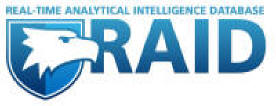

 NDIC created RAID to manage large quantities of data gathered during DOMEX operations. RAID is a relational database used to record key pieces of information and to quickly identify links among people, places, businesses, financial accounts, telephone numbers, and other investigative information examined by our analysts. The software runs on any Windows operating system (Windows 2000 or higher), in any mode of operation (stand-alone or LAN). It can be used to analyze any type of information from any kind of investigation or as a case management tool.
NDIC created RAID to manage large quantities of data gathered during DOMEX operations. RAID is a relational database used to record key pieces of information and to quickly identify links among people, places, businesses, financial accounts, telephone numbers, and other investigative information examined by our analysts. The software runs on any Windows operating system (Windows 2000 or higher), in any mode of operation (stand-alone or LAN). It can be used to analyze any type of information from any kind of investigation or as a case management tool.
NDIC has enhanced RAID to meet the expanding support requirements of the intelligence and law enforcement communities. The improved RAID can be used for both DOMEX and investigative case intelligence support. RAID also facilitates our capability to conduct Cross-Case Analysis. Key upgrade features include increased data storage, scalability (small database to very large, supporting a few users to hundreds), more comprehensive and efficient analytical tools, enhanced multimedia capability, an import/export wizard, dynamic additional data fields (configurable by users), data access security, easier combination/separation of cases, and the ability to apply data mining technologies across data sets.
The RAID application was created at NDIC around 1995 using Microsoft Access and has evolved into a robust tool capable of exporting data into powerful commercially available analytical software. It was developed by analysts for analysts to provide better intelligence and data support in large investigations. The software helps specialists catalog and analyze valuable information gleaned from seized evidence, Reports of Investigation, and other intelligence sources. The RAID application allows the creation and linking of data in a distributed environment. This means, records created by an analyst are instantly available to other analysts and updates are seen in real-time. Data contained in RAID can also be displayed visually using commercially available analytical software such as i2 Analyst’s Notebook and Geographic Information Systems (GIS) such as ArcGIS.
RAID also readily imports and exports data to and from other databases, computer files, and multiple analytical tools. This greatly assists us in capturing data obtained through Media Exploitation. We have expanded the multimedia capability to capture all types of media and computer files and link them to any records in the database. Further, we are able to hyperlink the extracted intelligence back to a copy of the original or scanned copy. Electronic media from computers and other sources are typically exploited and imported electronically into RAID prior to DOMEX analysts working on an investigation. That permits all of the available evidence to be synthesized and analyzed for the most comprehensive examination of the data.
RAID is a multi-user Relational Database Management System (RDBMS) used by NDIC as well as other intelligence and law enforcement agencies. In fact, more than 4,000 copies of the application have been distributed to agencies both domestically and in some international locations. The new version (RAID 3) operates with Microsoft Database Engine (MSDE) and Microsoft’s SQL Server platform. This will ensure that we can provide a copy our database to any agency we support without requiring additional software to operate.
RAID 3 has significant improvements to its analysis functions including the ability to perform cross case analysis. The fact that the database is scalable from a small database to a very large database enables it to be queried across multiple cases by any number of analytical tools to enable our analysts to identify commonalities among the records, within a single database and across multiple datasets. After the commonalities are identified, the entity records can be linked across multiple cases and saved in the RAID data warehouse. This allows us to build-on the connections and intelligence developed from previous cross-case projects.
To meet the challenges of changing data requirements we have created dynamic functions within the database which different users can configure to meet their specific requirements. RAID 3 includes Customizable Fields which allow users to easily add new data fields for a specific project on all of the main records without changing the database code or affecting underlying data structure. The new application still comes with a set of standard reports, but users will also be able to create, save, and modify reports to meet their specific requirements for any particular project. RAID 3 also includes the ability to set defaults. RAID 3 can also apply the appropriate classification and caveat labels and restrict access based on user permissions. Other organizations use RAID in different ways and may now set up their own default values and organizational settings. Lastly RAID 3 was designed to be internationalized in several ways. Its code and database objects are localized to allow the software to be translated into other languages efficiently.
NDIC offers the RAID 3 training free of cost (travel costs and per diem are not included) to law enforcement agencies. In this 5-day course, users will be trained on the RAID software so that evidentiary and investigatory information can be effectively retrieved to assist organizations with their investigations. No prior experience with RAID 3 or any previous versions of RAID are needed. For additional information or to register, call the Registrar at (814) 532-4028 or e-mail ndic.training@usdoj.gov.
Please send all requests for DOMEX support as well as copies of RAID to:
Document & Media Exploitation Branch
National Drug Intelligence Center
319 Washington Street, 5th Floor
Johnstown, PA 15901-1622
Telephone: (814) 532-4601
Fax: (814) 532-5854





